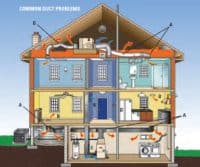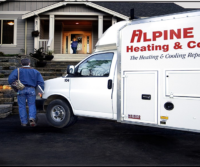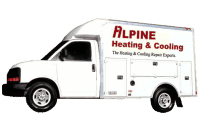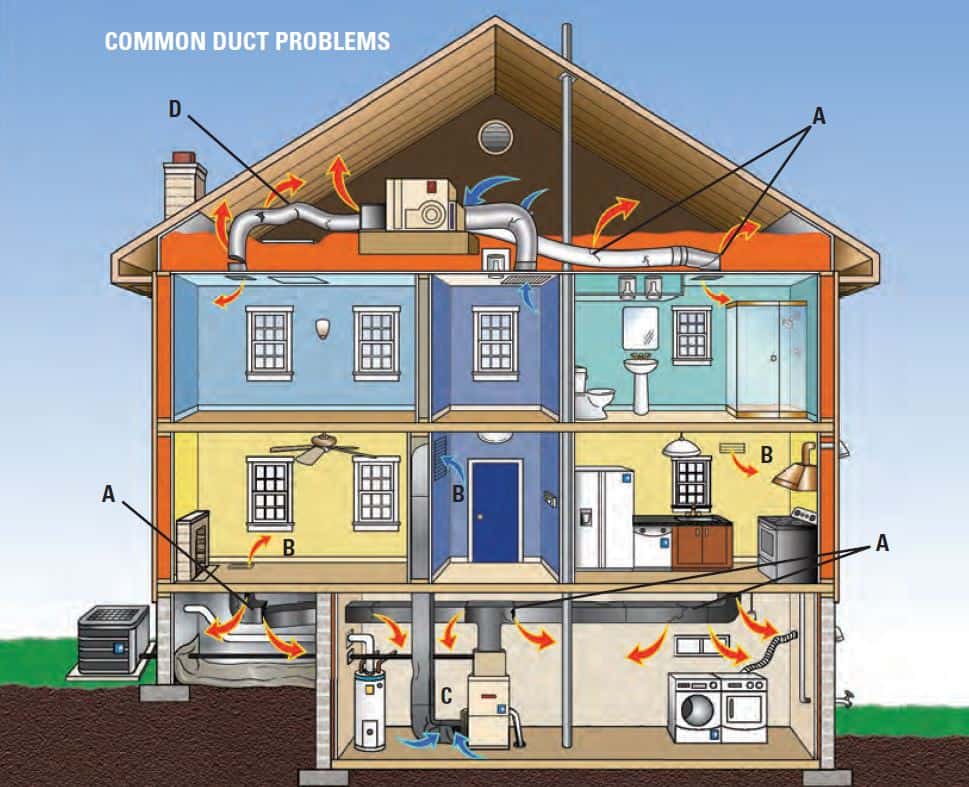
Ducts are used to distribute conditioned air throughout houses with forced-air heating and cooling systems. In
typical Skagit Valley houses, about 20 percent of the air that moves through the duct system is getting lost due to leaks, holes, and poorly connected ducts. The result is an inefficient HVAC system, high utility bills, and difficulty keeping the house comfortable, no matter how you set the thermostat.
Simple Steps to Improving Duct Performance
Because ducts are often concealed in walls, ceilings, attics, and basements, repairing them can be difficult. But there are things that you can do to improve duct performance in your house.
Start by sealing leaks using mastic sealant or metal (foil) tape and insulating all the ducts that you can access such as those in the attic, crawlspace, basement, or garage. Never use ‘duct tape,’ as it is not long-lasting.
Also make sure that the connections at vents and registers are well-sealed where they meet the floors, walls, and ceiling. These are common locations to find leaks and disconnected ductwork.
A: Leaky, torn, and disconnected ducts
B: Poorly sealed registers and grills
C: Leaks at furnace and filter slot
D: Kinks in flexible ductwork restricting airflow
Contact Alpine Heating and Cooling for more information on duct improvement projects.
- inspect the entire duct system,
- evaluate the system’s supply and return air balance,
- repair or replace damaged, disconnected, or undersized ducts and straighten out flexible ducts that are tangled or crushed,
- seal leaks and connections with mastic, metal tape, or an aerosol-based sealant.
- seal gaps behind registers and grills where the duct meets the floor, wall, or ceiling
- insulate ducts in unconditioned areas with insulation that carries an R-value of 6 or higher
- include a new filter as part of any duct system improvement
- Use diagnostic tools to evaluate air flow after repairs are completed
- Ensure there is no back drafting of gas or oil-burning appliances, and conduct a combustion safety test after ducts are sealed.

A programmable thermostat is ideal for people who are away from home during set periods throughout the week. Through proper use of pre-programmed settings, a programmable thermostat can save you about $180 every year in energy costs in Skagit Valley.
How Do You Choose the Right Programmable Thermostat or You?
To decide which model is best for you, think about your schedule and how often you are away from home for regular periods—work, school, other
activities—and then decide which of the three different models best fits your schedule:
- 7-day models are best if your daily schedule tends to change; for example, if
children are at home earlier on some days. These models give you the most
flexibility and let you set different programs for different days—usually with four
possible temperature periods per day. - 5+2-day models use the same schedule every weekday, and another
for weekends. - 5-1-1 models are best if you tend to keep one schedule Monday through Friday
and another schedule on Saturdays and Sundays.
Programmable Thermostat Settings
You can use the table below as a starting point for setting energy-saving temperatures and then adjust the settings to fit your family’s schedule and stay comfortable.

Get the Greatest Benefit from Your Programmable Thermostat
- Install your thermostat away from heating or cooling registers, appliances,
lighting, doorways, fireplaces, skylights and windows, and areas that receive
direct sunlight or drafts. Interior walls are best. - Keep the thermostat set at energy-saving temperatures for long periods of time,
such as during the day when no one is home and at bedtime. - Set the “hold” button at a constant energy-saving temperature when going
away for the weekend or on vacation. - Resist the urge to override the pre-programmed settings. Every time you do, you
use more energy and may end up paying more on your energy bill. - Use a programmable thermostat for each zone of your house if you have
multiple heating and cooling zones. This will help you maximize comfort,
convenience, and energy savings throughout the house. - Change your batteries each year if your programmable thermostat runs on
batteries. Some units will indicate when batteries must be changed.
If you have a heat pump, you may require a special programmable thermostat to maximize your energy savings year-round. Talk to your retailer or contractor for details before selecting your thermostat.
If you have a manual thermostat, you can adjust the temperatures daily before you leave the house and when you go to sleep at night. Typically, adjusting temperatures 5 – 8 degrees (down in winter, up in summer) can help save energy if you are going to be away from home for several hours.

Dirt and neglect are the top causes of heating and cooling system inefficiency and failure in Skagit Valley. To ensure an efficient system
operation, it’s essential to maintain your HVAC system.
Change your air filter regularly. A clean filter will prevent dust and dirt from building up in the system, which can lead to expensive maintenance and early system failure. Check your filter every month, especially during winter and summer months, when use tends to be heavier. Change your filter if it’s dirty—or at least every three months to maintain your HVAC system properly.
Tune up your HVAC equipment. Proper maintenance by an Alpine Heating and Cooling qualified technician is one of the most important steps you can take to prevent future problems. We get busy during the summer and winter months, so it is best to check the cooling system in spring and the heating system in the fall. Plan the checkups around the beginning and end of daylight-saving time each spring and fall.
Overall HVAC System Maintenance Checklist
- Check thermostat settings to ensure the heating and cooling system turns
on and off at the programmed temperatures. - Tighten all electrical connections and measure voltage and current on
motors. Faulty electrical connections can cause your system to operate
unsafely and reduce the life of major components. - Lubricate moving parts. Parts that lack lubrication cause friction in motors
and increase the amount of electricity you use. Lack of lubrication can also
cause equipment to wear out more quickly, requiring more frequent repairs
or replacements. - Check and inspect the condensate drain in your central air conditioner,
furnace, and heat pump (when in cooling mode). If plugged, the drain
can cause water damage in the house, affect indoor humidity levels, and
breed bacteria and mold. - Check system controls to ensure proper and safe operation. Check the starting
cycle of the equipment to assure the system starts, operates, and shuts
off properly. - Inspect, clean, or change the air filter in your central air conditioner, furnace,
and heat pump. Your contractor can show you how to do this yourself.
Depending on your system, your filter may be located in the duct system versus
the heating and cooling equipment itself.
Additional HVAC System-Specific Maintenance Activities
For Heating Systems:
- Inspect the flue piping for rusting and any disconnections or evidence of
back drafting. - Check all gas (or oil) connections, gas pressure, burner combustion, and heat
exchanger. Improper burner operation can be caused by a dirty burner or a
cracked heat exchanger—either can cause the equipment to operate less safely
and efficiently. Leaking gas (or oil) connections are also a fire hazard and can
contribute to health problems.
For Cooling Systems:
- Clean indoor and outdoor coils before warm weather starts. A dirty coil
reduces the system’s ability to cool your home and causes the system to run
longer, increasing your energy costs and shortening the life of your equipment. - Check your central air conditioner’s refrigerant charge and adjust it if
necessary to make sure it meets manufacturer specifications. Too much or too
little refrigerant charge can damage the compressor, reducing the life of your
equipment and increasing costs. - Clean and adjust blower components to provide proper system airflow. Proper
airflow over the indoor coil is necessary for efficient equipment operation
and reliability.
Alpine Heating & Cooling services all of Skagit Valley including Anacortes, La Conner, Mount Vernon, Sedro-Woolley, and Burlington. Contact us today to schedule maintenance for your HVAC system!

If you smell gas or suspect that you have a natural gas leak, leave the area immediately and call PSE at 1-888-225-5773 or dial 911.
How to know you have a gas leak
Smell
In its natural state, natural gas is odorless, tasteless and non-toxic. But because it’s also flammable, PSE adds a distinctive sulfur or “rotten egg” smell to the gas that’s delivered to your home or business. If you’re unfamiliar with this odor (the smell of gas), test the “scratch and sniff” spot inside of the gas safety brochure.
Look and listen
You may also see or hear signs of a gas leak, including:
- Bubbles rising in a puddle or other pool of liquid
- Dust or dirt blowing from a hole in the ground
- Dead or dying vegetation in unexpected locations
- Hissing (small perforation) or roaring (large break)
Natural gas versus carbon monoxide
Both natural gas and carbon monoxide (CO) are naturally odorless and potentially harmful. But unlike natural gas, CO has no added scent to help you detect exposure.
To learn more about CO, visit Carbon Monoxide Safety .
What to do
If you detect or even suspect that you have a natural gas leak:
- Leave the area immediately. If you’re indoors, evacuate the building.
- Call PSE at 1-888-225-5773 or call 911, but don’t use your landline phone, which may cause a spark.
- Don’t do anything else that might create a spark, including flipping any switches on or off.
- PSE will immediately dispatch a technician to check that your area is safe, at no charge.
Brochure request
To request a gas safety brochure, call 1-888-225-5773.

Consider Making a Change to Your HVAC System if Any of the Following Statements Apply
Some of your rooms are too hot or cold. Inadequate air sealing or insufficient insulation could be the cause. No matter how efficient your heating and cooling system is, if your home is not adequately sealed and insulated, you will not be as comfortable, and your system will have to work harder. Your home has humidity problems, excessive dust, or rooms that never seem to get comfortable. Leaky or poorly insulated ductwork might be the cause and reason to change your HVAC system.
Your equipment needs frequent repairs, and your energy bills are going up. In addition to the rise in energy costs, the age and condition of your heating and cooling equipment may have caused it to become less efficient. Call Alpine Heating & Cooling to take a look at your current system. Alpine can offer you solutions that work for your budget.
Your heating and cooling equipment is more than ten years old. Consider replacing it with newer, more efficient equipment. And remember, high-efficiency levels begin with ENERGY STAR.
You leave your thermostat set at one constant temperature. You could be missing a great energy-saving opportunity. You can set a programmable thermostat to adjust your home’s temperature at times when you’re regularly away or sleeping.
You used EPA’s ENERGY STAR Home Energy Yardstick to compare your household’s energy use to others across the country, and your score is below five. That means you’re using and paying for more energy at home than most Americans. Visit the ENERGY STAR Home Advisor to get recommendations for home improvement projects that will increase your score by improving your home’s energy efficiency and comfort.

Nothing is more frustrating than when your HVAC system stops working when you need it most, causing you to consider an emergency air conditioning and furnace repair or replacement. Not only is it stressful for you and your family to be without air conditioning or heat, but it can also be a financial strain. There are a few things you can do, however, before calling Alpine Heating & Cooling.
Emergency Air Conditioning and Furnace Repair Checklist
1: Check your furnace’s air filter – if you have not replaced or cleaned it in a while, you may want to purchase a new one, since a dirty filter can restrict airflow through your home.
2: Check your circuit breakers – the breaker switch may have tripped or shut off by accident. It is important to keep in mind that a tripped HVAC breaker may indicate a more serious issue, so schedule an inspection with us immediately.
3: Make sure the vents in your home are not obstructed – Blocked or closed vents can limit the airflow through your home.
4: Check the thermostat – if your thermostat uses a battery, it could need to be changed. You can also check to see if there is dust or dirt in the thermostat by removing the faceplate. If there is dust or dirt, use a can of compressed air to gently remove it. Also, frequently changing the temperature on the thermostat can cause the compressor in your system to overheat and shut down. To avoid this, be patient once you set your desired temperature. The system could take up to five minutes for the HVAC system to turn on.
If after going through this emergency HVAC repair checklist and your unit is still not functioning properly, it may be time to call us. A malfunctioning HVAC system could drive up your energy costs along with the expensive emergency furnace and air conditioning repairs. Time is of an essence. Alpine Heating & Cooling will travel to your home in our Skagit Valley service area to assess the HVAC system and create an estimate for the repair and complete the repair.

Maintain your HVAC equipment to prevent future problems and unwanted costs. Keep your cooling and heating system at peak performance by having Alpine Heating and Cooling do annual pre-season check-ups. We get busy once summer and winter come, so it’s best to check the cooling system in the spring and the heating system in the fall. To remember, you might plan the check-ups and spring maintenance around the time the daffodils starting blooming for the La Conner Daffodil Festival and in the fall around the Festival of Family Farms.

A Typical Spring Maintenance Check-up Should Include the Following
- Check thermostat settings to ensure the cooling and heating system keeps you comfortable when you are home and saves energy while you are away.
- Tighten all electrical connections and measure voltage and current on motors. Faulty electrical connections can cause unsafe operation of your system and reduce the life of major components.
- Lubricate all moving parts. Parts that lack lubrication cause friction in motors and increases the amount of electricity you use.
- Check and inspect the condensate drain in your central air conditioner, furnace and/or heat pump (when in cooling mode). A plugged drain can cause water damage in the house and affect indoor humidity levels.
- Check controls of the system to ensure proper and safe operation. Check the starting cycle of the equipment to assure the system starts, operates, and shuts off properly.
Cooling Specific
- Clean evaporator and condenser air conditioning coils. Dirty coils reduce the system’s ability to cool your home and cause the system to run longer, increasing energy costs and reducing the life of the equipment.
- Check your central air conditioner’s refrigerant level and adjust if necessary. Too much or too little refrigerant will make your system less efficient increasing energy costs and reducing the life of the equipment.
- Clean and adjust blower components to provide proper system airflow for greater comfort levels. Airflow problems can reduce your system’s efficiency by up to 15 percent.
Heating Specific
- Check all gas (or oil) connections, gas pressure, burner combustion and heat ex-changer. Improperly operating gas (or oil) connections are a fire hazard and can contribute to health problems. A dirty burner or cracked heat ex-changer causes improper burner operation. Either can cause the equipment to operate less safely and efficiently.
Actions To Do Yourself
- Inspect, clean, or change air filters once a month in your central air conditioner, furnace, and/or heat pump. Your contractor can show you how to do this. A dirty filter can increase energy costs and damage your equipment, leading to early failure.
With all of the severe watches and warnings this winter in Skagit County, you may need help fast with your HVAC system! The freezing temperatures are expected to stick around. Skagit County has seen 2-6 inches of snowfall overnight Sunday and the snow will not be melting for several days. If you are having issues with your heating system, we can provide fast service.



